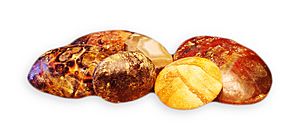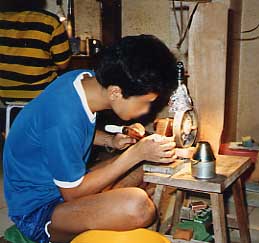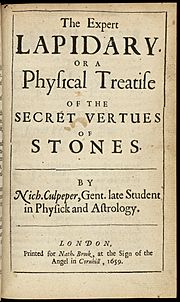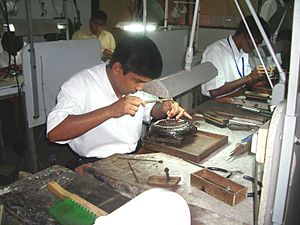Lapidary facts for kids
A lapidary is a skilled artist or craftsperson. They shape and polish stones, minerals, or gemstones into decorative items. These items can be smooth, rounded shapes called cabochons, or stones with many flat surfaces called faceted designs. They also create engraved gems, which are stones with pictures carved into them.
Lapidaries use special methods like cutting, grinding, and polishing. Working with very hard stones often needs special carving skills. People who cut diamonds are usually called diamond cutters, not lapidaries. This is because diamonds are so hard they need unique tools and methods.
In the past, the word "gemcutter" meant someone who carved gems like jade. Today, it usually means someone who cuts diamonds. Sometimes, the word "lapidary" can also refer to people who collect or sell gems, or anyone who knows a lot about precious stones.
Contents
What Does "Lapidary" Mean?
The word lapidary comes from the Latin word lapis, which means "stone." Around the 1300s, it changed from lapidarius (meaning "stonecutter") to the Old French word lapidaire. This meant "someone skilled in working with precious stones."
In French, and later in English, lapidary also meant a book about precious stones. These books described how stones looked, how they formed, and their special qualities. In medieval Europe, people believed stones had powers. They thought stones could prevent harm, heal sickness, or offer health benefits. The word lapidary started being used as an adjective (a describing word) in English in the 1700s.
History of Lapidary Work
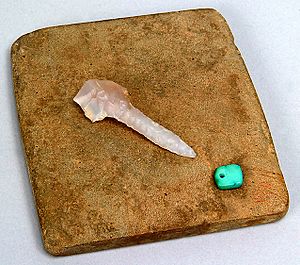
The first known lapidary work probably happened during the Stone Age. As early humans made tools from stone, they learned that some stones were harder than others. The next early examples of lapidary art involved drilling holes in stone and rock. People started drilling rocks about one million years ago.
The ancient Egyptians became very good at cutting and shaping stones. They used materials like lapis lazuli, turquoise, and amethyst to make jewelry.
The art of lapidary was very developed in India by the early 100s CE. Old texts from India, like the Buddhist Rathanpariksha (from the 200s CE), talk about lapidary arts. Hindu texts from the mid-400s CE, such as Agni Purana, also describe these skills. These books discuss where gems and diamonds come from, their qualities, how to test them, and how to cut and polish them for jewelry. Many other Sanskrit texts about gems show that lapidary was a continuous practice in India.
Experts believe that people traded lapidary products between Africa and India in the 1000s CE. People in India and along the coast of East Africa had developed their own lapidary methods before the 900s. This is shown by old writings and things found in archaeological digs.
Lapidary was also very important in early Mesoamerica (parts of Central and North America). Lapidary items were used as symbols of power, for offerings, and in burials. They were made from shells, jade, turquoise, and greenstones. Aztec lapidaries used simple tools like string saws and drills made from reeds and bone.
Lapidary Techniques
There are three main types of lapidary work:
- Tumbling: This involves putting rough stones in a machine that tumbles them with abrasive grit. This smooths and polishes them.
- Cabochon cutting: This creates smooth, rounded, polished stones with a flat bottom.
- Faceting: This involves cutting many flat, polished surfaces (facets) onto a stone to make it sparkle.
Most modern lapidary work uses machines with motors. For polishing, lapidaries use special powders or pastes. These include silicon carbide, aluminium oxide, or diamond dust. They use smaller and smaller particles until the stone is shiny. Often, the final polish uses materials like tin oxide or cerium(IV) oxide.
Cutting harder stones is done with a saw that has a diamond edge. For softer materials, other abrasive materials can be used, like silicon carbide or garnet. Because diamonds are so hard, cutting them always needs diamond tools. Water, oil, or other liquids are usually used to keep the tools cool and clean during cutting, grinding, and polishing.
Beyond these main types, there are other special lapidary techniques:
- Casting: Creating shapes by pouring melted material into a mold.
- Carving: Shaping stone by cutting away parts.
- Jewelry making: Setting finished stones into metal designs.
- Mosaic: Creating pictures by joining small pieces of stone or glass.
Another special lapidary technique is called pietra dura. This means "hard stone" in Italian. It involves inlaying (setting) pieces of marble and gemstones into a marble base. Stones like onyx, jasper, and carnelian are often used. This technique started in Florence and Naples, Italy, in the 1500s. The Medici Chapel at San Lorenzo in Florence is completely covered with inlaid hard stones.
Micromosaics are another type of lapidary work. They became popular in the late 1700s in Naples and Rome. In this technique, tiny pieces of glass are put together to create detailed pictures. In China, carving jade has been a continuous lapidary tradition since at least the Shang Dynasty.
Lapidary Clubs and Shows
There are lapidary clubs all over the world. In Australia, there are many gem shows, including a big yearly competition called GEMBOREE. In Tucson, Arizona, a large group of gem and mineral shows happens every February. It started with the Tucson Gem and Mineral Society Show. Now, many other shows happen at the same time. In 2012, this group of shows was the biggest gem and mineral event in the world.
See also
 In Spanish: Lapidario (profesión) para niños
In Spanish: Lapidario (profesión) para niños


